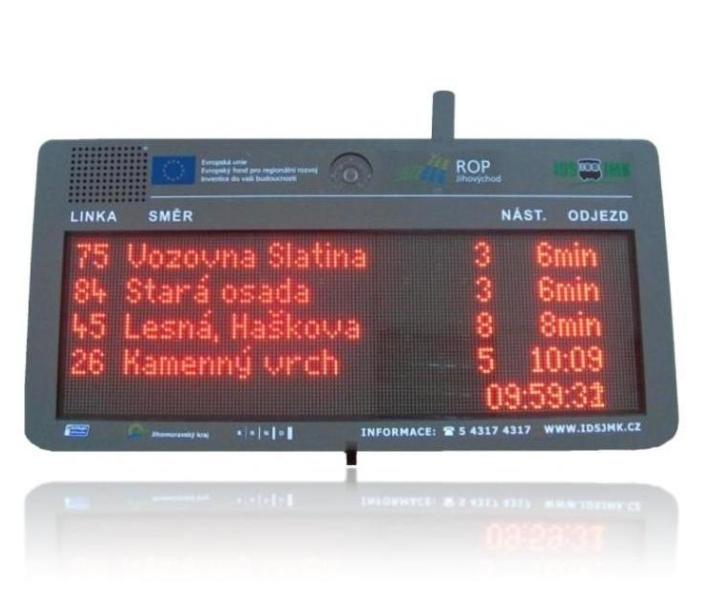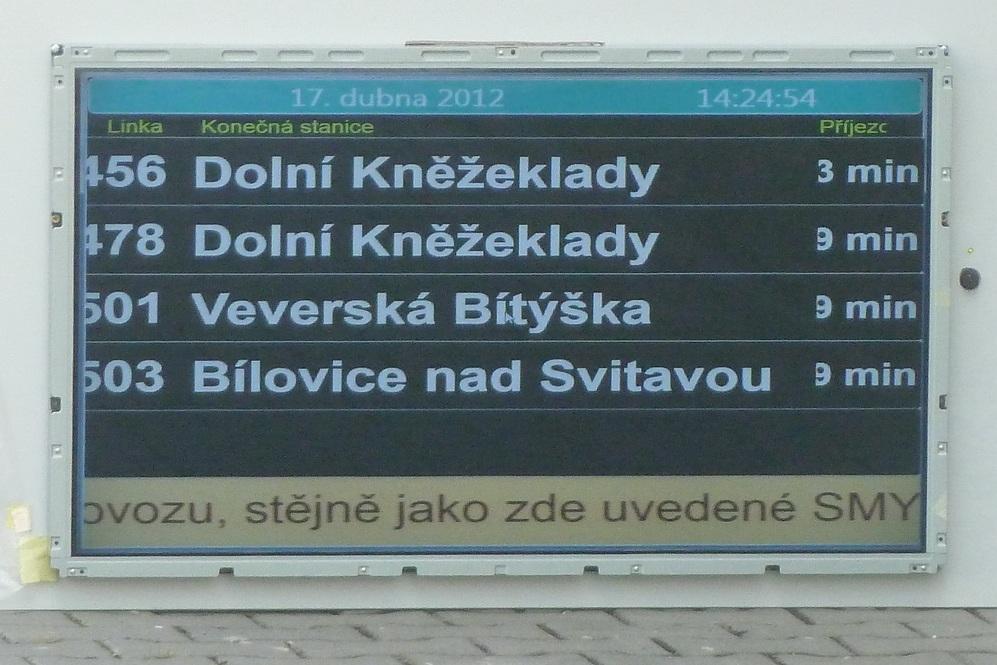Comparison of LCD and LED displays
- Articles and technical information
- Articles
The technology for displaying information using a matrix of Light-Emitting Diode (LED) diodes or Liquid-Crystal Display (LCD) displays works on a completely different principle. Both technologies have both pros and cons when used in the same conditions, especially in outdoor environments.
LED panel colour - solutions
Display panels consisting of several thousand LEDs are currently the most widely used technology for displaying information in public transport for external use. In LED panels, each LED represents one display point within the information area and thus corresponds to one 'large' pixel in LCD displays. The colour display capability of LED panels depends on the type of LED used (the so-called multi-LED chip) and the colours used in it. Compared to full-colour LCD displays, the LED display method can generally be divided as follows:
- Monochrome - usually the colours red, yellow, green, white and possibly others. Suitable for displaying text and simple graphics with consistent luminance throughout the panel. Sufficient for bus stop panels and signage.These panels are cheaper than LCD panels for external use.
- Two basic colours - usually a combination of red-green or red-yellow, or other combinations. A total of three colours can be displayed, with the third colour created when both LEDs in one housing are lit simultaneously (e.g. red - green - orange). The price of this panel is at least 50% higher than the previous solution. The colour resolution makes it easy for passengers to distinguish between e.g. train, urban and suburban traffic.
- Three basic colours - here it is already a standard full-colour triple LED, i.e. a multi-LED containing individual LEDs such as red - green - blue. In the case of the cheaper solution, the individual colours are only switched and do not allow a full colour picture. This is usually not used.
- Three basic colours with full graphic luminance control - this design fully matches the behaviour of dots on LCD displays, but the dot has a much higher luminance. This type of LED panel is suitable for outdoor use and replaces LCD screens here, however it has more complex control with lumen control of each LED 'chip' even within a multi-LED. These panels are several times more expensive than similar LCD panels, but have many times higher luminance and thus sunlight readability.
In the case of single-colour LED panels, only information consisting of the individual characters of the character set used can be displayed (some characters can be modified into simple pictograms to achieve a partial graphic effect). In contrast, LCD displays can normally display at least 256,000 colours or more.
Therefore, it is preferable to focus on flickering fields for LED displays if we want to emphasize a given text or pictogram. Inverted text displays due to "large" display dots can cause poor readability.
Comparison of panel legibility in full sunlight
Panels made up of a matrix of LEDs are characterised by very good viewing angles, especially when using so-called flat LEDs, where the viewing angle is practically about 170° or more, and have very good legibility in all lighting conditions. The LED panels are thus suitable for use both indoors and outdoors where there is a possibility of direct sunlight on the display area of the panel.
LCD displays have a major disadvantage compared to LED panels when displayed in direct sunlight, where the backlighting of the display cannot "backlight" the LCD display area so strongly that readability is comparable to LED panels, even for displays with increased backlight power and special optical "banding" and solar filters. Information displayed on an LCD in direct sunlight is difficult to read from a distance in both negative and positive text displays. The photographs in Figures 2a and 2b were taken at midday in full sun (100 000 Cd/m2 luminous flux), which is 100× the luminous flux of a high-brightness LCD display. The reason for the readability of LED displays in direct sunlight is very simple - even with current LCD manufacturing technologies with increased backlight power, LED panels have approximately 20× the brightness.
Readability of LED panels in direct sunlight - with a contrasting film, it is always easy to read
Readability of the 42" high-brightness LCD panels in direct sunlight at midday - photographed from a distance of 5 m (essentially unreadable from a greater distance). LCD panel brightness during the test was 1150 Cd/m.
Comparison of LCD and LED panel lifetimes
The lifetime of both LCD and LED panels is fundamentally affected by brightness intensity. All LCD and LED displays supplied by Ing. Ivo Herman, CSc. are equipped with an illumination sensor regulating the brightness of the displays to prolong their lifetime and avoid unpleasant glare of people at night or in reduced ambient light.
Since LEDs have much higher brightness as standard, in most cases their performance is significantly reduced while maintaining comfortable readability according to ambient brightness. This makes it possible to guarantee a minimum lifetime of 150,000 hours for LED panels (due to the voltage regulation on the LEDs).
For LCD displays with increased brightness values, the maximum brightness is still approximately 20 times lower than for LED panels, which means a more frequent need for maximum brightness to comfortably display information on the screen. Because of the frequent use of the maximum brightness value for a display, the lifetime of the display is drastically reduced. This also leads to the need to replace the LCD display more frequently (if there is a model on the market that is compatible with the piece being replaced) after approximately 5 years, the display electronics will last longer. For external use, it is necessary to choose LCDs that can operate at 105 °C and especially then cool a lot from the inside. The basic problem is heating of the LCD by the sun's rays.
Illustration of a 42" LCD display under different lighting conditions
As already mentioned in Fig. 2 - when the LCD display is fully lit, the sunlight is about 100 times more intense, which makes the LCD panel difficult to read. For the sake of completeness, we show in Figure 3 a situation in which the LCD panels are placed in the shade in the same sunlight. However, according to Table 3, in the shade the sunlight is about 10 times less and this already ensures the readability of the displayed information even at midday.
Readability of the 42" high-brightness LCD panels in the shade behind the building (full sun in front of the building - no clouds), photographed from a distance of 5 m. LCD panel brightness during the test was 1150 Cd/m2 - estimated ambient light 10-12 thousand. Cd/m2.
Photo of the LCD panel in shade and when the sun is hidden under clouds. Here its already full seamless readability of display and text. Estimated ambient sunlight was 7-8k. Cd/m2.
Comparison of parameters of similar LED and LCD panels (approx. 42")
From the previous description, it is clear that the LED panel has a significantly lower number of displayable pixels per area (resolution) compared to the LCD display, with similar active area dimensions. However, this does not prevent, for example, the display of text with good legibility even more than 25 m from the panel. Compared to the LCD display, the LED panel has a significantly higher maximum brightness, which guarantees a very high quality display of information even in direct sunlight. The values in the table for LED panel and LCD display are based on currently used and available technologies
A brightness value of 1000 - 2500 Cd/m² is one of the highest possible values for an LCD panel that can be purchased today. To give you an idea, the values of standard LCD displays for laptops or desktop LCD monitors are in the range of 200 - 350 Cd/m²
LCD displays with brightness values in the range of 200 - 500 Cd/m² are completely unsuitable for outdoor use. In direct sunlight, such displays are usually completely black - completely unreadable and can be damaged by direct sunlight. When using a display with increased brightness above >900 Cd/m², such a display remains at least partially legible at closer distances.
In summary, the advantages of LED over LCD can be stated:
- Higher luminance and thus better readability in direct sunlight
- Significantly lower average power consumption
- Significantly higher operating temperature range
- Significantly higher panel lifetime
- Reduced panel maintenance
Table 1: Parameters of size-comparable display units
LED panel 5 rows | 42″ LCD | |
|---|---|---|
Graphics area size | 1000 × 300 [mm] | 930 × 523 [mm] |
Total graphic area | 0,3m² | 0,48m² |
Number of columns × number of rows | 160 × 50 | 1920 × 1080 |
Number of luminous pixels | 8000 | 2.0736 mil. |
Dot/pixel brightness | 1,000 Cd | 0.00027 Cd |
Total panel/display brightness | 26,680 Cd/m² | 1150 Cd/m² |
Power consumption per dot/pixel | 20mA | 0.081mA |
Total power consumption - max. full ¹) | 160W | 180W |
Total power consumption - max. text ²) | 40W | 180W |
Total power consumption - night full | 40W | 90W |
Total power consumption - night text | 10W | 90W |
Annual consumption [kWh/year] ³) | ≅157kWh | ≅1184kWh |
Temperature range | -40°C to +100°C | -0°C to +50°C |
Lifetime [hrs] 4) | 150000 / 17 years | 50000 / 5.7 years |
- Maximum luminous flux with all diodes fully lit
- text luminosity is approx. 25% of the active panel area (only the illuminated points consume energy)
- the consumption does not include the consumption of the panel control unit. Here again, the LED panel controller has a lower consumption of 2-5W, for the LCD panel it has a consumption of about 5-10W and higher. The consumption is constant.
- This applies to the voltage regulation used for LED panels made by Herman and the use of OSRAM diodes.
In our opinion, the advantages of the LCD display over LED panels do not need to be emphasized, as they are generally known - full color display with graphic area, easy change of display and fine dot grid.
Design parameters of the LCD display
LCD displays also differ significantly in their design. The design is considerably more complicated than that of an LED panel. It is the complexity of the panel design that makes it challenging to produce large panels with extended brightness ranges and operating temperatures.
In the case of lower operating temperatures for the display, additional heating of the display can be used or, conversely, on summer days it must include cooling of the display (forced ventilation). This solution is more costly to procure and increases the overall energy cost of operation.
The second biggest issue is the design of the display backlight to achieve the highest possible brightness. Although LCD display technology is still evolving, it is currently impossible to get LCD displays with brightness values of more than 1500 Cd/m².
Operating temperature range according to LCD size
- Normal temperature range (0°C to +50°C): all LCD sizes
- Extended temperature range (-20°C to +70°C): sizes up to 30"
- Wide temperature range (-30°C to +85°C): sizes up to 24"
Problems associated with the delivery of panels equipped with LCD displays
- Large LCD displays over 30" are not manufactured with extended temperature range (cooling and heating for the display must be provided, which increases costs)
- Maximum brightness for LCD displays for outdoor use is approximately 1,200 Cd/m², up to 1,500 Cd/m² for smaller displays
- LCDs with increased brightness for outdoor use (above 500 Cd/m²) are much wider than standard displays (mechanical designs) because they contain special filters against sunlight
- LCD displays with increased brightness (above 500 Cd/m²) are several times more expensive than a standard display with brightness up to 350 Cd/m².
Example of LCD composition.
Table 2: Properties of the individual elements in an LCD display.
Parts of an LCD | Material | Temperature data | Effects of high temperatures |
|---|---|---|---|
Polarizing film | PVA, TAC, PET | 80°C, 500 hours | |
Glass with coloured filter | Glass | without limitation | NA |
Liquid crystals | Extended temperature range | -35°C to 95°C | Blackout - renewable |
Standard temperature range | -20°C to 75°C | Blackout - renewable | |
Polarising film | Glass | 80°C, 500 hours | NA |
Optical film | PVA, TAC, PET | < 85° | Image ripple - irreversible |
Light guide plate | PVA, PET | < 95° | Deformation - irreversible |
Plastic frame | PMMA (plastic) | < 95° | Deformation - irreversible |
Light source | LED | -35°C to 85°C | Reduced lifetime at high temperatures |
LED driver | IO | Depends on design |
Technology comparison
 Table 3 shows the brightness values according to the different environments against which the brightness values of the two display technologies can be compared. According to the above photos of the LCD display and its parameters when compared with the brightness table, it is quite obvious that the LCD display is more suitable for outdoor areas with protection against direct sunlight. Because even with the use of high quality optical filters over the display, the readability in direct sunlight as with LED panels cannot be achieved.
Table 3 shows the brightness values according to the different environments against which the brightness values of the two display technologies can be compared. According to the above photos of the LCD display and its parameters when compared with the brightness table, it is quite obvious that the LCD display is more suitable for outdoor areas with protection against direct sunlight. Because even with the use of high quality optical filters over the display, the readability in direct sunlight as with LED panels cannot be achieved.
- The LCD display is suitable for indoor and possibly outdoor areas with protection against direct sunlight.
- The LED panel is suitable where the sun will shine on it for a significant part of the day and it should be readable from a greater distance (10 metres or more).
For this comparison, we show an example of an add-on LCD marker (not our product) and the ELP 143B/160R LED marker manufactured by us, where the reason for the replacement was complaints from the travelling public about the legibility of the markers, particularly in the summer months. Both photos were taken on the same day with a difference of about one hour on 6.12.2017, i.e. under the same lighting conditions. On that day, the ambient brightness was about 3000 Cd/m2, i.e. 30 times less than in full sun (more on the LCD vs. LED comparison here). In this case, the luminance was relatively low, so the difference in luminance is not large, yet the difference in readability from 10 meters is significant.
For a full picture, we list the luminance values in the table below:
Table 3: Illuminance values in different environments.
Light source | Luminance (L [cd/m²]) |
|---|---|
Illuminance at night under full moon | 0,2 |
Lighting for comfortable reading | 50 |
Office lighting | 300 |
Excellent room lighting | 700 |
Sunlight, one hour before sunset | 1 000 |
Daylight, cloudy | 3 000 |
Sunny day in the shade of a tree | 10 000 |
Bright sunlight at noon | 100 000 |








